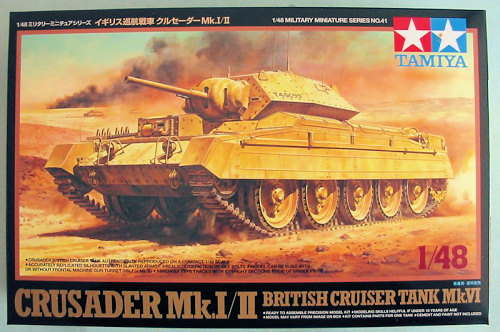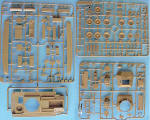
| KIT: | Tamiya 1/48 Crusader I/II |
| KIT #: | ? |
| PRICE: | 1900 yen at www.hlj.com |
| DECALS: | Five options |
| REVIEWER: | Tom Cleaver |
| NOTES: |

| HISTORY |
Great Britain invented the tank in the First World War, but following the war the British Army did its level best to forget that fact for as long as possible. As a result, most British tanks used during the Second World War were not the equal of their opponents, though through the courage of their crews they did manage to forge a memorable history.
What became known as the “cruiser tank” was originally developed conceptually by Hobart and Liddell-Hart during the 1920s. Taking the name from the naval vessel, the cruiser tank was to be fast and mobile, and able to operate independently of the infantry and their heavier and slower support tanks. The tanks were to take advantage of the situation once gaps had been punched in the enemy’s front line, with the cruisers penetrating to the rear where they would attack lines of supply and communications. They were not supposed to take on enemy tanks on the main battlefield, but were to raise havoc with the unarmored trucks and other vehicles, the way the cavalry had been used to disrupt the supply train in earlier wars. Because of this requirement, speed was critical, and the early designs were lightly armored and armed. Unfortunately, the cruiser tanks would be employed against enemy armor when they entered combat in the Second World War, and their thin armor and small-caliber weapons resulted in the Germans inflicting many casualties.
In 1930, a British military mission observed Soviet high-speed BT tanks on field maneuvers, and were impressed by their performance. The BT was developed from the designs of the American, Walter Christie, whose suspension system was far superior to that used on any other armored vehicle. The result of this was the development of the A-13 Mk.I and Mk.II, the first British tank to be fitted with a Christie suspension.
In 1939, the British Army asked Nuffield Mechanization and Aero to participate in production of the A13 Mk III, which later became the Tank, Cruiser Mk V "Covenanter" which was then in the design stage. Nuffield counter-offered with a proposal to develop its own version of the A13,which was adopted “off the drawing board” as the Tank, Cruiser, Mk VI Crusader, under the General Staff specification A15. While the Crusader is often described as an improved version of the Covenanter, it was in fact a parallel design. Despite starting later, Nuffield delivered the prototype of the Crusader six weeks before the first Covenanter was produced.
Unlike the A13 series, the Crusader had five road wheels on each side, which improved weight distribution. Additionally it differed from the Covenanter by having a different engine, a different steering system, and a more conventional cooling system with radiators in the engine compartment. A small hand-traversed auxiliary turret equipped with a Besa machine gun was mounted on the left side of the front hull. This proved difficult to use and was often removed in the field or left unoccupied. Both the A-13 Covenanter and the A15 Crusader used the same main turret, with early vehicles using a semi-internal cast mantlet that was quickly replaced by a better protected big cast mantlet with three vertical slits for the main gun, a coaxial Besa, and a sighting telescope. Both the Mk. I and Mk. II Crusader had only 20mm turret and 26mm hull frontal armor, and were equipped with a 2-pounder (40mm) gun. While the Crusader was superior to any of the Italian tanks it opposed in North Africa and with a top speed of more than 25 m.p.h. was faster than the German Pzkw III, the German tank’s 57mm cannon made it the superior battlefield weapon. The Crusader also suffered from mechanical unreliability, a problem in all British tanks until the Cromwell entered operations powered by the reliable Rolls-Royce Meteor engine.
Production of the tank began in May 1941 and the Crusader was sent to North Africa in the late Spring of 1971 to equip the 7th Armored Division in the Western Desert. The first combat operation was Operation Battleaxe, an attempt to relieve Tobruk.
The lack of a High Explosive (HE) shell for the main armament - which existed but was never supplied - allowed German tank forces to develop the tactic of engaging British tanks by retreating behind a screen of concealed 57mm and 88mm anti-tank guns. The pursuing British tanks would be engaged by the artillery, which was out of range of the tanks' machine guns. Without a high explosive shell to return fire, the British had the equally bad options of retiring under fire or advancing to overrun the AT gun screen, which meant heavy losses either way.
The equipment of the British armored force in North Africa with American tanks, first the M-3 Lee and then the M-4 Sherman gave the British more effective tanks for use against German armor, and the Crusader was retired from the armored forces by the end of the North African campaign. Many of these tanks were later modified as gun tractors for the 17-pounder howitzer or as mobile anti-aircraft batteries.
While the Crusader was not the best tank of its era, it held its own against its opponents and formed the backbone of the British armored force during the desperate battles against Rommel’s panzers in the Western Desert.
| THE KIT |
 As is now standard with Tamiya’s 1/48 armor, the Crusader comes with a diecast
lower hull, with the upper hull, road wheels and tracks, and turret in injection
molded plastic, which come on four flash-free sprues of light brown plastic.
As is now standard with Tamiya’s 1/48 armor, the Crusader comes with a diecast
lower hull, with the upper hull, road wheels and tracks, and turret in injection
molded plastic, which come on four flash-free sprues of light brown plastic.
Decals provide markings for two Mk.I Crusaders and three Mk.II Crusaders, one of which is in the later camouflage of desert yellow and charcoal black.
| CONCLUSIONS |
This kit provides an important tank in British armored history, one that belongs in any collection of the armored vehicles that fought in the desert. Back when I was a teenager, I had a book written by a former British tanker that recounted his experiences fighting in North Africa with the Crusader tank, and I have always been interested in the vehicle due to his accounts of those desperate battles. I look forward to adding this soon to my collection of 1/48 armor.
Review kit courtesy of HobbyLink Japan. Get yours at “Japanese prices” at www.hlj.com
If you would like your product reviewed fairly and quickly by a site that has nearly 300,000 visitors a month, please contact me or see other details in the Note to Contributors.